Report on Establishing & Implementing Plans for Cooperative Behaviour
VerifiedAdded on 2020/07/23
|30
|9453
|398
Report
AI Summary
This report provides a detailed analysis of establishing and implementing plans for developing cooperative behavior. It begins with an introduction to the essential elements required for effective planning, organization, staffing, leading, and controlling in a workplace setting. The report then focuses on developing behavior guidelines for children, emphasizing the importance of understanding and managing child behaviors through a child-centered policy that respects their dignity. It explores various factors influencing child behavior, including age, development, health, and environmental settings, and outlines strategies to promote positive behaviors. The report covers setting limits, reinforcing positive behaviors, establishing realistic expectations, and utilizing various behavior management techniques such as prevention, positive redirection, modeling, limit setting, problem-solving, and logical consequences. The report also addresses strategies for informing children about expectations, minimizing factors that maintain inappropriate behaviors, and evaluating the effectiveness of plans. The report concludes with a discussion on the importance of a collaborative approach involving staff, parents, and external agencies to achieve desired outcomes in fostering cooperative behavior.
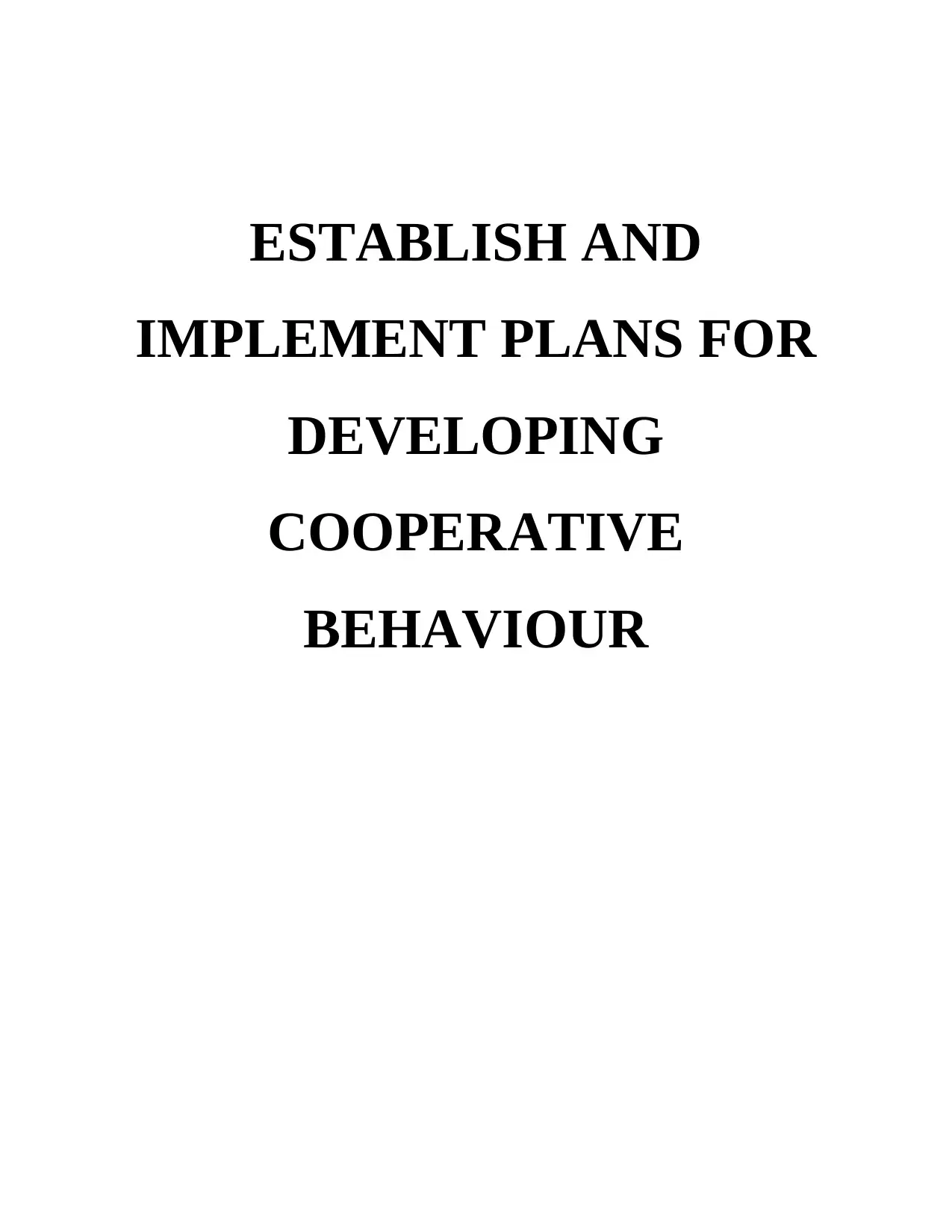
ESTABLISH AND
IMPLEMENT PLANS FOR
DEVELOPING
COOPERATIVE
BEHAVIOUR
IMPLEMENT PLANS FOR
DEVELOPING
COOPERATIVE
BEHAVIOUR
Paraphrase This Document
Need a fresh take? Get an instant paraphrase of this document with our AI Paraphraser
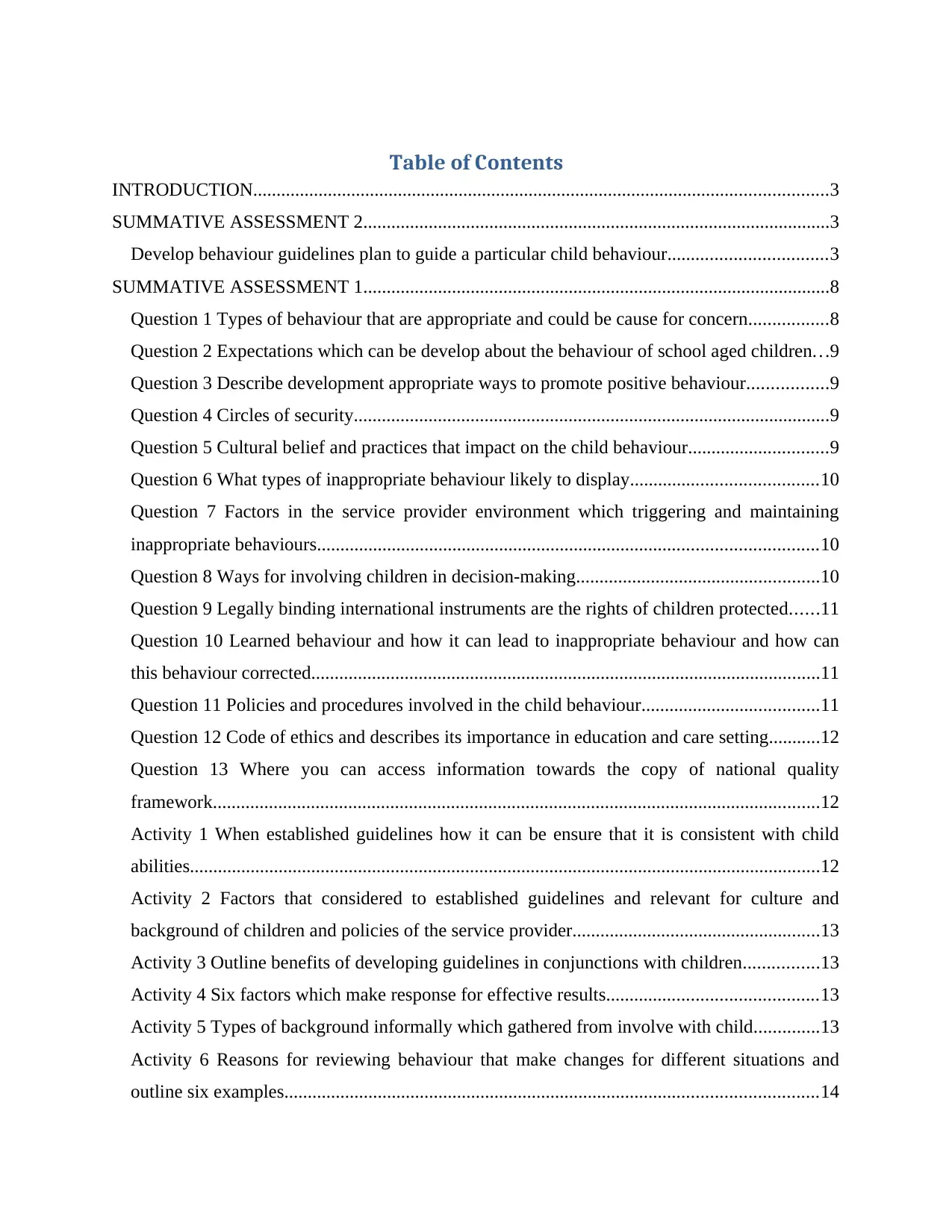
Table of Contents
INTRODUCTION...........................................................................................................................3
SUMMATIVE ASSESSMENT 2....................................................................................................3
Develop behaviour guidelines plan to guide a particular child behaviour..................................3
SUMMATIVE ASSESSMENT 1....................................................................................................8
Question 1 Types of behaviour that are appropriate and could be cause for concern.................8
Question 2 Expectations which can be develop about the behaviour of school aged children...9
Question 3 Describe development appropriate ways to promote positive behaviour.................9
Question 4 Circles of security......................................................................................................9
Question 5 Cultural belief and practices that impact on the child behaviour..............................9
Question 6 What types of inappropriate behaviour likely to display........................................10
Question 7 Factors in the service provider environment which triggering and maintaining
inappropriate behaviours...........................................................................................................10
Question 8 Ways for involving children in decision-making....................................................10
Question 9 Legally binding international instruments are the rights of children protected......11
Question 10 Learned behaviour and how it can lead to inappropriate behaviour and how can
this behaviour corrected.............................................................................................................11
Question 11 Policies and procedures involved in the child behaviour......................................11
Question 12 Code of ethics and describes its importance in education and care setting...........12
Question 13 Where you can access information towards the copy of national quality
framework..................................................................................................................................12
Activity 1 When established guidelines how it can be ensure that it is consistent with child
abilities.......................................................................................................................................12
Activity 2 Factors that considered to established guidelines and relevant for culture and
background of children and policies of the service provider.....................................................13
Activity 3 Outline benefits of developing guidelines in conjunctions with children................13
Activity 4 Six factors which make response for effective results.............................................13
Activity 5 Types of background informally which gathered from involve with child..............13
Activity 6 Reasons for reviewing behaviour that make changes for different situations and
outline six examples..................................................................................................................14
INTRODUCTION...........................................................................................................................3
SUMMATIVE ASSESSMENT 2....................................................................................................3
Develop behaviour guidelines plan to guide a particular child behaviour..................................3
SUMMATIVE ASSESSMENT 1....................................................................................................8
Question 1 Types of behaviour that are appropriate and could be cause for concern.................8
Question 2 Expectations which can be develop about the behaviour of school aged children...9
Question 3 Describe development appropriate ways to promote positive behaviour.................9
Question 4 Circles of security......................................................................................................9
Question 5 Cultural belief and practices that impact on the child behaviour..............................9
Question 6 What types of inappropriate behaviour likely to display........................................10
Question 7 Factors in the service provider environment which triggering and maintaining
inappropriate behaviours...........................................................................................................10
Question 8 Ways for involving children in decision-making....................................................10
Question 9 Legally binding international instruments are the rights of children protected......11
Question 10 Learned behaviour and how it can lead to inappropriate behaviour and how can
this behaviour corrected.............................................................................................................11
Question 11 Policies and procedures involved in the child behaviour......................................11
Question 12 Code of ethics and describes its importance in education and care setting...........12
Question 13 Where you can access information towards the copy of national quality
framework..................................................................................................................................12
Activity 1 When established guidelines how it can be ensure that it is consistent with child
abilities.......................................................................................................................................12
Activity 2 Factors that considered to established guidelines and relevant for culture and
background of children and policies of the service provider.....................................................13
Activity 3 Outline benefits of developing guidelines in conjunctions with children................13
Activity 4 Six factors which make response for effective results.............................................13
Activity 5 Types of background informally which gathered from involve with child..............13
Activity 6 Reasons for reviewing behaviour that make changes for different situations and
outline six examples..................................................................................................................14
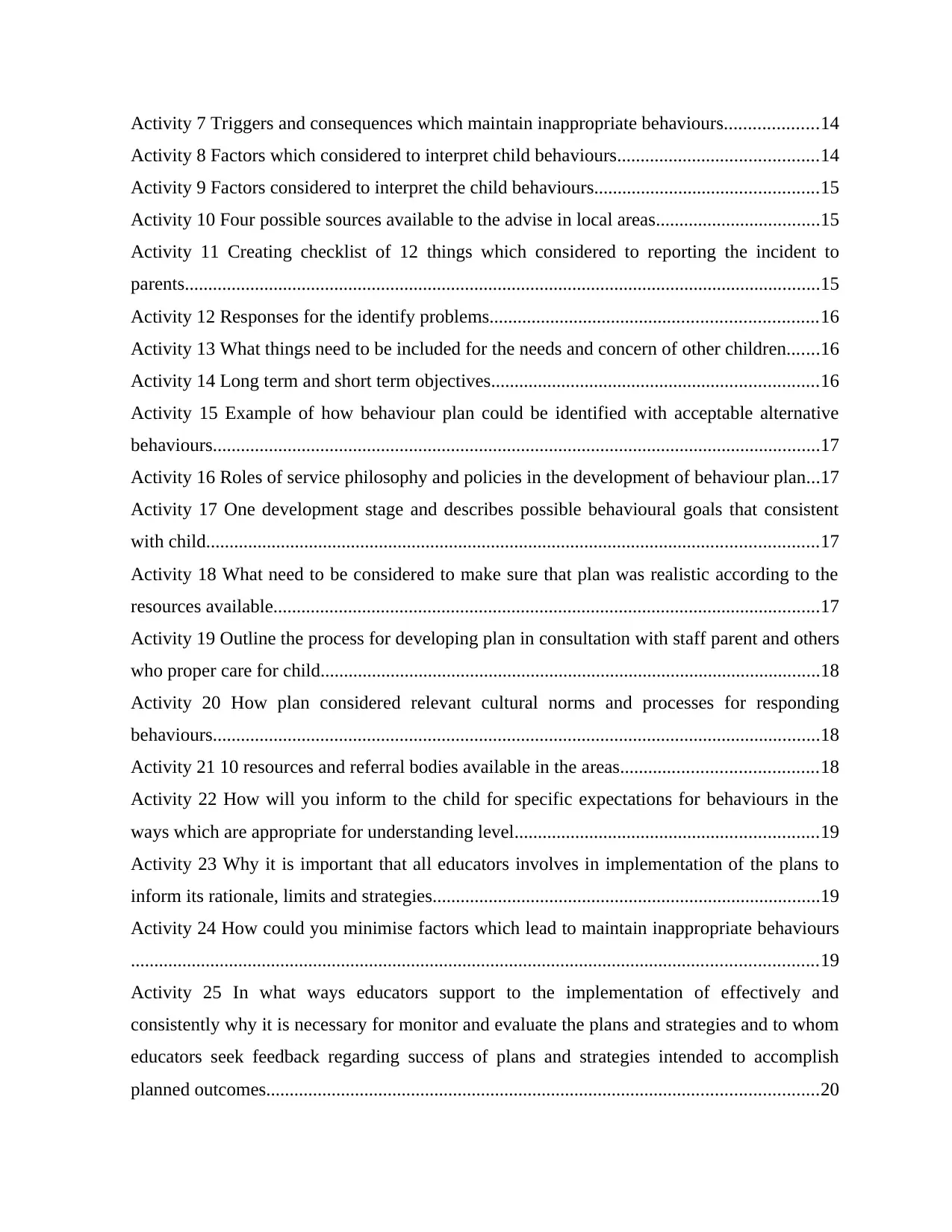
Activity 7 Triggers and consequences which maintain inappropriate behaviours....................14
Activity 8 Factors which considered to interpret child behaviours...........................................14
Activity 9 Factors considered to interpret the child behaviours................................................15
Activity 10 Four possible sources available to the advise in local areas...................................15
Activity 11 Creating checklist of 12 things which considered to reporting the incident to
parents........................................................................................................................................15
Activity 12 Responses for the identify problems......................................................................16
Activity 13 What things need to be included for the needs and concern of other children.......16
Activity 14 Long term and short term objectives......................................................................16
Activity 15 Example of how behaviour plan could be identified with acceptable alternative
behaviours..................................................................................................................................17
Activity 16 Roles of service philosophy and policies in the development of behaviour plan...17
Activity 17 One development stage and describes possible behavioural goals that consistent
with child...................................................................................................................................17
Activity 18 What need to be considered to make sure that plan was realistic according to the
resources available.....................................................................................................................17
Activity 19 Outline the process for developing plan in consultation with staff parent and others
who proper care for child...........................................................................................................18
Activity 20 How plan considered relevant cultural norms and processes for responding
behaviours..................................................................................................................................18
Activity 21 10 resources and referral bodies available in the areas..........................................18
Activity 22 How will you inform to the child for specific expectations for behaviours in the
ways which are appropriate for understanding level.................................................................19
Activity 23 Why it is important that all educators involves in implementation of the plans to
inform its rationale, limits and strategies...................................................................................19
Activity 24 How could you minimise factors which lead to maintain inappropriate behaviours
...................................................................................................................................................19
Activity 25 In what ways educators support to the implementation of effectively and
consistently why it is necessary for monitor and evaluate the plans and strategies and to whom
educators seek feedback regarding success of plans and strategies intended to accomplish
planned outcomes......................................................................................................................20
Activity 8 Factors which considered to interpret child behaviours...........................................14
Activity 9 Factors considered to interpret the child behaviours................................................15
Activity 10 Four possible sources available to the advise in local areas...................................15
Activity 11 Creating checklist of 12 things which considered to reporting the incident to
parents........................................................................................................................................15
Activity 12 Responses for the identify problems......................................................................16
Activity 13 What things need to be included for the needs and concern of other children.......16
Activity 14 Long term and short term objectives......................................................................16
Activity 15 Example of how behaviour plan could be identified with acceptable alternative
behaviours..................................................................................................................................17
Activity 16 Roles of service philosophy and policies in the development of behaviour plan...17
Activity 17 One development stage and describes possible behavioural goals that consistent
with child...................................................................................................................................17
Activity 18 What need to be considered to make sure that plan was realistic according to the
resources available.....................................................................................................................17
Activity 19 Outline the process for developing plan in consultation with staff parent and others
who proper care for child...........................................................................................................18
Activity 20 How plan considered relevant cultural norms and processes for responding
behaviours..................................................................................................................................18
Activity 21 10 resources and referral bodies available in the areas..........................................18
Activity 22 How will you inform to the child for specific expectations for behaviours in the
ways which are appropriate for understanding level.................................................................19
Activity 23 Why it is important that all educators involves in implementation of the plans to
inform its rationale, limits and strategies...................................................................................19
Activity 24 How could you minimise factors which lead to maintain inappropriate behaviours
...................................................................................................................................................19
Activity 25 In what ways educators support to the implementation of effectively and
consistently why it is necessary for monitor and evaluate the plans and strategies and to whom
educators seek feedback regarding success of plans and strategies intended to accomplish
planned outcomes......................................................................................................................20
⊘ This is a preview!⊘
Do you want full access?
Subscribe today to unlock all pages.

Trusted by 1+ million students worldwide
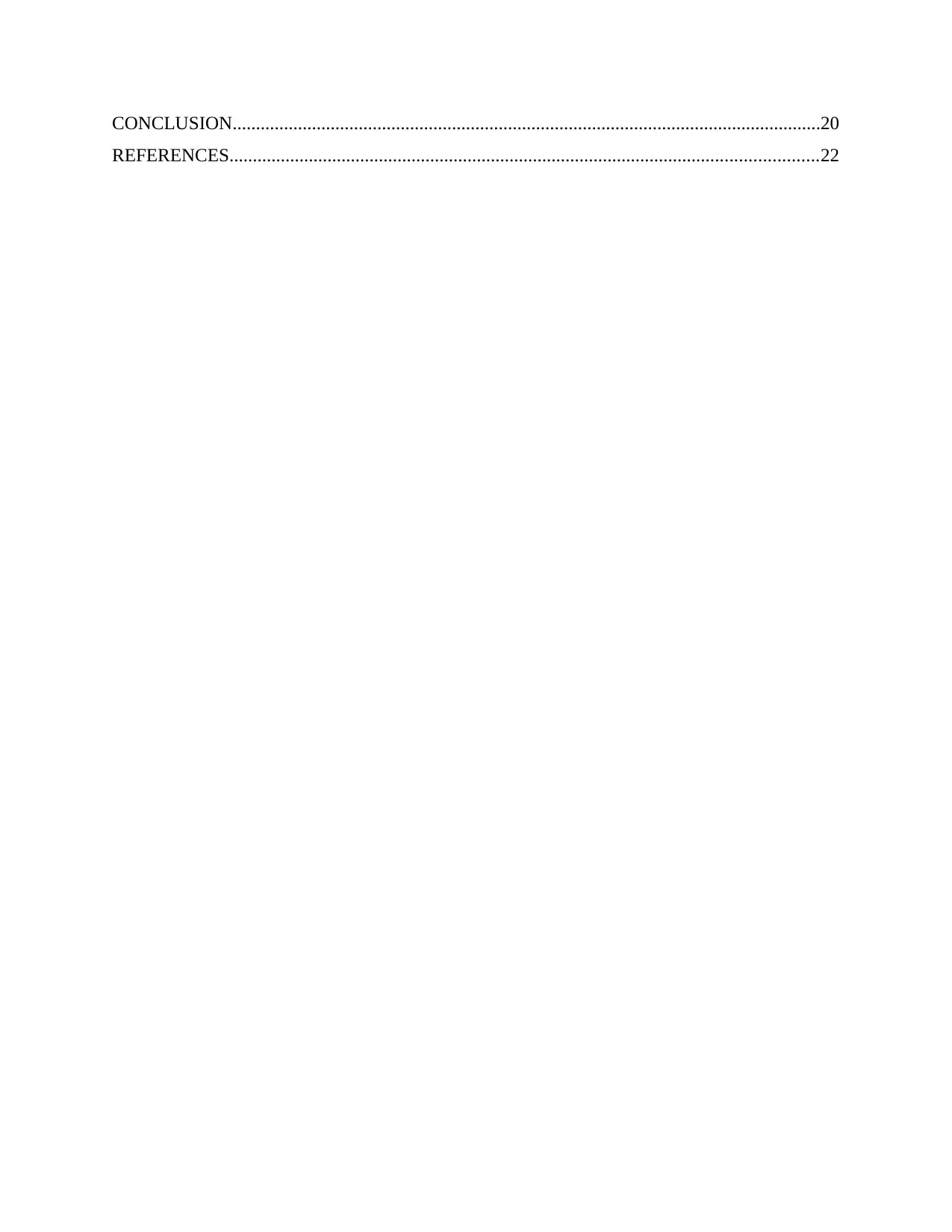
CONCLUSION..............................................................................................................................20
REFERENCES..............................................................................................................................22
REFERENCES..............................................................................................................................22
Paraphrase This Document
Need a fresh take? Get an instant paraphrase of this document with our AI Paraphraser
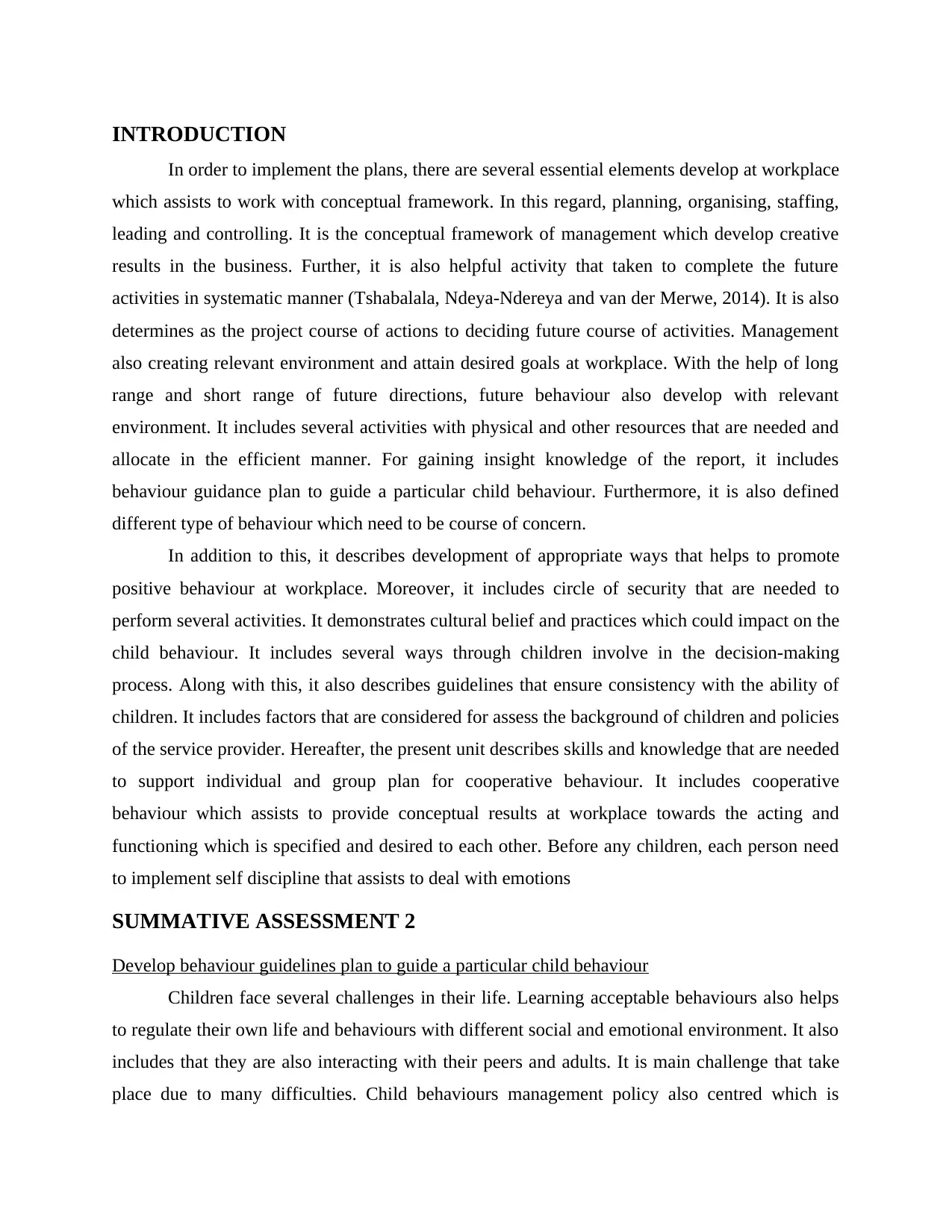
INTRODUCTION
In order to implement the plans, there are several essential elements develop at workplace
which assists to work with conceptual framework. In this regard, planning, organising, staffing,
leading and controlling. It is the conceptual framework of management which develop creative
results in the business. Further, it is also helpful activity that taken to complete the future
activities in systematic manner (Tshabalala, Ndeya-Ndereya and van der Merwe, 2014). It is also
determines as the project course of actions to deciding future course of activities. Management
also creating relevant environment and attain desired goals at workplace. With the help of long
range and short range of future directions, future behaviour also develop with relevant
environment. It includes several activities with physical and other resources that are needed and
allocate in the efficient manner. For gaining insight knowledge of the report, it includes
behaviour guidance plan to guide a particular child behaviour. Furthermore, it is also defined
different type of behaviour which need to be course of concern.
In addition to this, it describes development of appropriate ways that helps to promote
positive behaviour at workplace. Moreover, it includes circle of security that are needed to
perform several activities. It demonstrates cultural belief and practices which could impact on the
child behaviour. It includes several ways through children involve in the decision-making
process. Along with this, it also describes guidelines that ensure consistency with the ability of
children. It includes factors that are considered for assess the background of children and policies
of the service provider. Hereafter, the present unit describes skills and knowledge that are needed
to support individual and group plan for cooperative behaviour. It includes cooperative
behaviour which assists to provide conceptual results at workplace towards the acting and
functioning which is specified and desired to each other. Before any children, each person need
to implement self discipline that assists to deal with emotions
SUMMATIVE ASSESSMENT 2
Develop behaviour guidelines plan to guide a particular child behaviour
Children face several challenges in their life. Learning acceptable behaviours also helps
to regulate their own life and behaviours with different social and emotional environment. It also
includes that they are also interacting with their peers and adults. It is main challenge that take
place due to many difficulties. Child behaviours management policy also centred which is
In order to implement the plans, there are several essential elements develop at workplace
which assists to work with conceptual framework. In this regard, planning, organising, staffing,
leading and controlling. It is the conceptual framework of management which develop creative
results in the business. Further, it is also helpful activity that taken to complete the future
activities in systematic manner (Tshabalala, Ndeya-Ndereya and van der Merwe, 2014). It is also
determines as the project course of actions to deciding future course of activities. Management
also creating relevant environment and attain desired goals at workplace. With the help of long
range and short range of future directions, future behaviour also develop with relevant
environment. It includes several activities with physical and other resources that are needed and
allocate in the efficient manner. For gaining insight knowledge of the report, it includes
behaviour guidance plan to guide a particular child behaviour. Furthermore, it is also defined
different type of behaviour which need to be course of concern.
In addition to this, it describes development of appropriate ways that helps to promote
positive behaviour at workplace. Moreover, it includes circle of security that are needed to
perform several activities. It demonstrates cultural belief and practices which could impact on the
child behaviour. It includes several ways through children involve in the decision-making
process. Along with this, it also describes guidelines that ensure consistency with the ability of
children. It includes factors that are considered for assess the background of children and policies
of the service provider. Hereafter, the present unit describes skills and knowledge that are needed
to support individual and group plan for cooperative behaviour. It includes cooperative
behaviour which assists to provide conceptual results at workplace towards the acting and
functioning which is specified and desired to each other. Before any children, each person need
to implement self discipline that assists to deal with emotions
SUMMATIVE ASSESSMENT 2
Develop behaviour guidelines plan to guide a particular child behaviour
Children face several challenges in their life. Learning acceptable behaviours also helps
to regulate their own life and behaviours with different social and emotional environment. It also
includes that they are also interacting with their peers and adults. It is main challenge that take
place due to many difficulties. Child behaviours management policy also centred which is
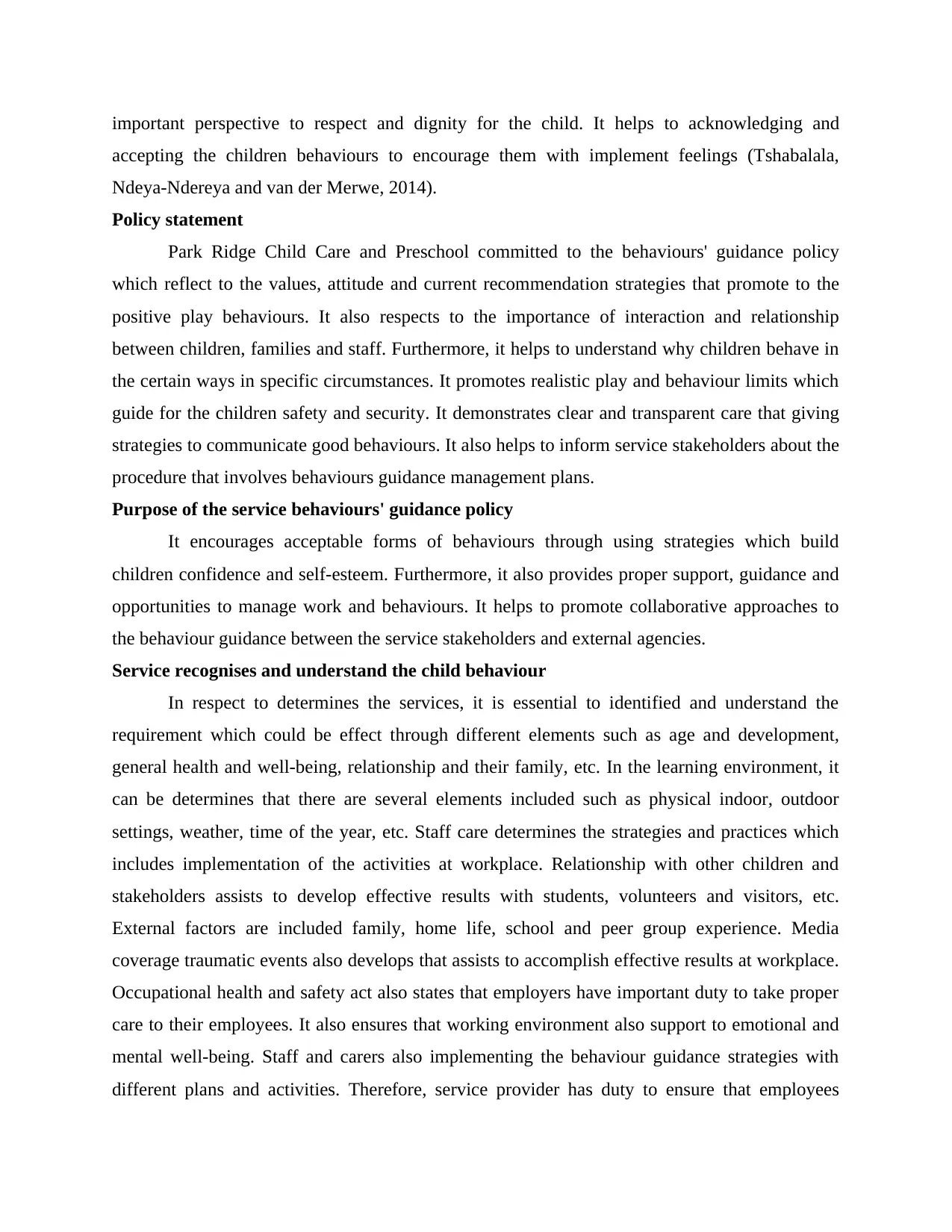
important perspective to respect and dignity for the child. It helps to acknowledging and
accepting the children behaviours to encourage them with implement feelings (Tshabalala,
Ndeya-Ndereya and van der Merwe, 2014).
Policy statement
Park Ridge Child Care and Preschool committed to the behaviours' guidance policy
which reflect to the values, attitude and current recommendation strategies that promote to the
positive play behaviours. It also respects to the importance of interaction and relationship
between children, families and staff. Furthermore, it helps to understand why children behave in
the certain ways in specific circumstances. It promotes realistic play and behaviour limits which
guide for the children safety and security. It demonstrates clear and transparent care that giving
strategies to communicate good behaviours. It also helps to inform service stakeholders about the
procedure that involves behaviours guidance management plans.
Purpose of the service behaviours' guidance policy
It encourages acceptable forms of behaviours through using strategies which build
children confidence and self-esteem. Furthermore, it also provides proper support, guidance and
opportunities to manage work and behaviours. It helps to promote collaborative approaches to
the behaviour guidance between the service stakeholders and external agencies.
Service recognises and understand the child behaviour
In respect to determines the services, it is essential to identified and understand the
requirement which could be effect through different elements such as age and development,
general health and well-being, relationship and their family, etc. In the learning environment, it
can be determines that there are several elements included such as physical indoor, outdoor
settings, weather, time of the year, etc. Staff care determines the strategies and practices which
includes implementation of the activities at workplace. Relationship with other children and
stakeholders assists to develop effective results with students, volunteers and visitors, etc.
External factors are included family, home life, school and peer group experience. Media
coverage traumatic events also develops that assists to accomplish effective results at workplace.
Occupational health and safety act also states that employers have important duty to take proper
care to their employees. It also ensures that working environment also support to emotional and
mental well-being. Staff and carers also implementing the behaviour guidance strategies with
different plans and activities. Therefore, service provider has duty to ensure that employees
accepting the children behaviours to encourage them with implement feelings (Tshabalala,
Ndeya-Ndereya and van der Merwe, 2014).
Policy statement
Park Ridge Child Care and Preschool committed to the behaviours' guidance policy
which reflect to the values, attitude and current recommendation strategies that promote to the
positive play behaviours. It also respects to the importance of interaction and relationship
between children, families and staff. Furthermore, it helps to understand why children behave in
the certain ways in specific circumstances. It promotes realistic play and behaviour limits which
guide for the children safety and security. It demonstrates clear and transparent care that giving
strategies to communicate good behaviours. It also helps to inform service stakeholders about the
procedure that involves behaviours guidance management plans.
Purpose of the service behaviours' guidance policy
It encourages acceptable forms of behaviours through using strategies which build
children confidence and self-esteem. Furthermore, it also provides proper support, guidance and
opportunities to manage work and behaviours. It helps to promote collaborative approaches to
the behaviour guidance between the service stakeholders and external agencies.
Service recognises and understand the child behaviour
In respect to determines the services, it is essential to identified and understand the
requirement which could be effect through different elements such as age and development,
general health and well-being, relationship and their family, etc. In the learning environment, it
can be determines that there are several elements included such as physical indoor, outdoor
settings, weather, time of the year, etc. Staff care determines the strategies and practices which
includes implementation of the activities at workplace. Relationship with other children and
stakeholders assists to develop effective results with students, volunteers and visitors, etc.
External factors are included family, home life, school and peer group experience. Media
coverage traumatic events also develops that assists to accomplish effective results at workplace.
Occupational health and safety act also states that employers have important duty to take proper
care to their employees. It also ensures that working environment also support to emotional and
mental well-being. Staff and carers also implementing the behaviour guidance strategies with
different plans and activities. Therefore, service provider has duty to ensure that employees
⊘ This is a preview!⊘
Do you want full access?
Subscribe today to unlock all pages.

Trusted by 1+ million students worldwide

require mental and emotional well-being to implement positive behaviours. It determines several
strategies to ascertain proper guidance and outcomes. On the other hand, staff are aware and
respect for the individual working environment. Therefore, it will support to the children and
families with ascertain background and belief. It is important activity that assists to accomplish
desire results at workplace (Starmer, O’Toole and Srivastava, 2014). There are certain external
factors exists that impact to the operations and functions such as family, home life, school and
peer group, etc. Further, group experience and media coverage of traumatic events also includes
families and staff display which respect and empathy to the children for their label behaviour and
not for individual child. It means that behaviours are managed but not managed children.
Strategies and practices
Strategies and practices develops with promoting positive approach that manage
behaviour of children. Encourages to the children ascertain creative results and program to
resolve the problem and issue. It solves issue of defeats and frustrations in the appropriate
manner. It could be achieved through explore possible solution that helps to children to
understand and deal with emotions (Ainscow, Beresford and West, 2013). It is also depends on
the child's age and their development level. It includes different steps towards establishment of
the good behaviours' management. Therefore, it includes following elements:
Setting and maintaining appropriate limit of the behaviour which encourages to children
which involved rules and display it on poster.
It also helps to explained appropriate use of the material and equipments which
established on the play spaces. It includes several areas in which children can find solace,
peace and relaxation (Baum, Lawless and Williams, 2013).
It reinforcing positive results with praise that assists to explain appropriate behaviour
with several solutions.
Setting realistic expectations also includes in age and stage with appropriate manner.
Calm also controlled with tone of voice and attitude which need to be assumed by the
caregiver in different situations. In order to make appropriate results, enterprise need to
includes proper form of physical punishment with children. It is also important to use the
child as a form of punishment.
It is also often and important for the work to develop effective results in the child
behaviours. Following are some behaviour management techniques implemented at workplace:
strategies to ascertain proper guidance and outcomes. On the other hand, staff are aware and
respect for the individual working environment. Therefore, it will support to the children and
families with ascertain background and belief. It is important activity that assists to accomplish
desire results at workplace (Starmer, O’Toole and Srivastava, 2014). There are certain external
factors exists that impact to the operations and functions such as family, home life, school and
peer group, etc. Further, group experience and media coverage of traumatic events also includes
families and staff display which respect and empathy to the children for their label behaviour and
not for individual child. It means that behaviours are managed but not managed children.
Strategies and practices
Strategies and practices develops with promoting positive approach that manage
behaviour of children. Encourages to the children ascertain creative results and program to
resolve the problem and issue. It solves issue of defeats and frustrations in the appropriate
manner. It could be achieved through explore possible solution that helps to children to
understand and deal with emotions (Ainscow, Beresford and West, 2013). It is also depends on
the child's age and their development level. It includes different steps towards establishment of
the good behaviours' management. Therefore, it includes following elements:
Setting and maintaining appropriate limit of the behaviour which encourages to children
which involved rules and display it on poster.
It also helps to explained appropriate use of the material and equipments which
established on the play spaces. It includes several areas in which children can find solace,
peace and relaxation (Baum, Lawless and Williams, 2013).
It reinforcing positive results with praise that assists to explain appropriate behaviour
with several solutions.
Setting realistic expectations also includes in age and stage with appropriate manner.
Calm also controlled with tone of voice and attitude which need to be assumed by the
caregiver in different situations. In order to make appropriate results, enterprise need to
includes proper form of physical punishment with children. It is also important to use the
child as a form of punishment.
It is also often and important for the work to develop effective results in the child
behaviours. Following are some behaviour management techniques implemented at workplace:
Paraphrase This Document
Need a fresh take? Get an instant paraphrase of this document with our AI Paraphraser
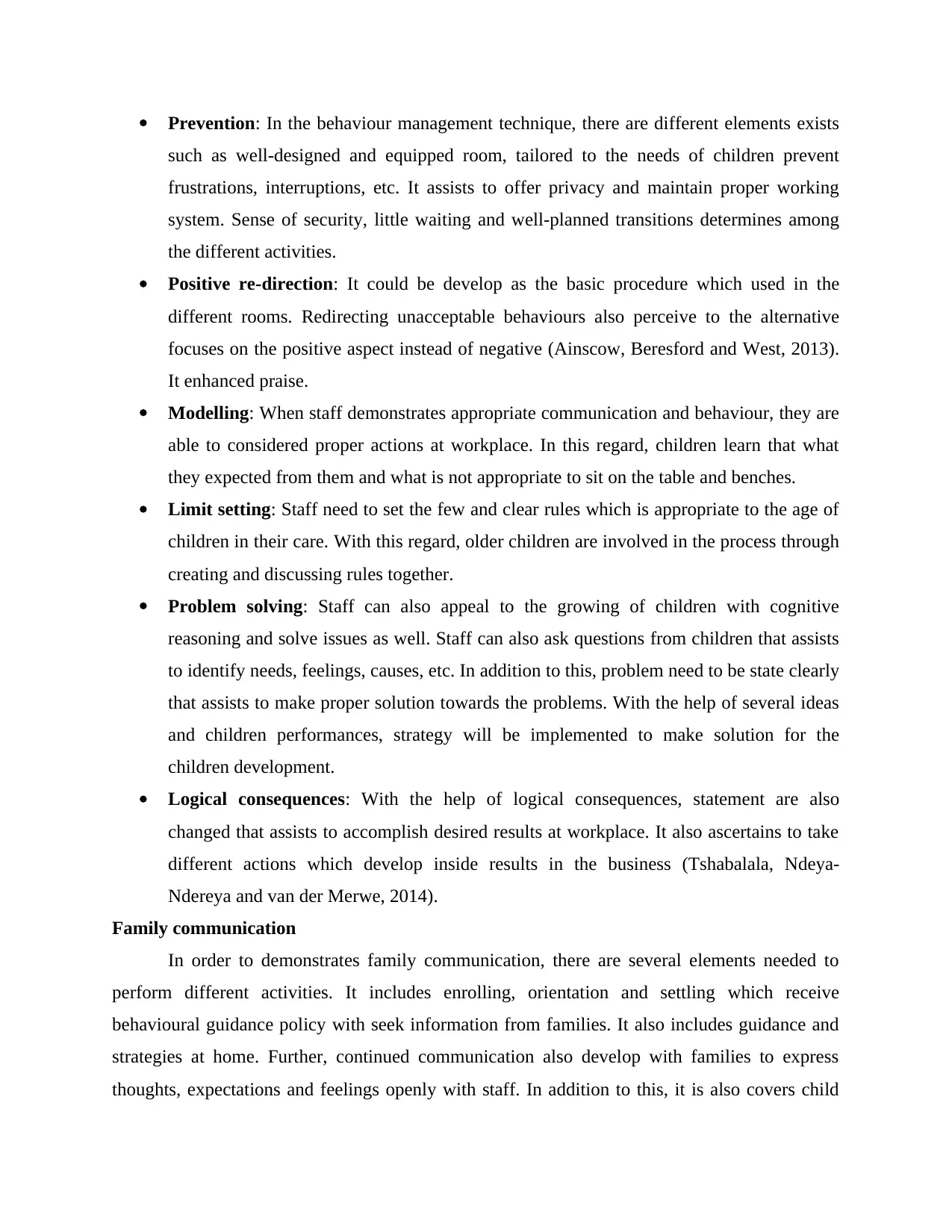
Prevention: In the behaviour management technique, there are different elements exists
such as well-designed and equipped room, tailored to the needs of children prevent
frustrations, interruptions, etc. It assists to offer privacy and maintain proper working
system. Sense of security, little waiting and well-planned transitions determines among
the different activities.
Positive re-direction: It could be develop as the basic procedure which used in the
different rooms. Redirecting unacceptable behaviours also perceive to the alternative
focuses on the positive aspect instead of negative (Ainscow, Beresford and West, 2013).
It enhanced praise.
Modelling: When staff demonstrates appropriate communication and behaviour, they are
able to considered proper actions at workplace. In this regard, children learn that what
they expected from them and what is not appropriate to sit on the table and benches.
Limit setting: Staff need to set the few and clear rules which is appropriate to the age of
children in their care. With this regard, older children are involved in the process through
creating and discussing rules together.
Problem solving: Staff can also appeal to the growing of children with cognitive
reasoning and solve issues as well. Staff can also ask questions from children that assists
to identify needs, feelings, causes, etc. In addition to this, problem need to be state clearly
that assists to make proper solution towards the problems. With the help of several ideas
and children performances, strategy will be implemented to make solution for the
children development.
Logical consequences: With the help of logical consequences, statement are also
changed that assists to accomplish desired results at workplace. It also ascertains to take
different actions which develop inside results in the business (Tshabalala, Ndeya-
Ndereya and van der Merwe, 2014).
Family communication
In order to demonstrates family communication, there are several elements needed to
perform different activities. It includes enrolling, orientation and settling which receive
behavioural guidance policy with seek information from families. It also includes guidance and
strategies at home. Further, continued communication also develop with families to express
thoughts, expectations and feelings openly with staff. In addition to this, it is also covers child
such as well-designed and equipped room, tailored to the needs of children prevent
frustrations, interruptions, etc. It assists to offer privacy and maintain proper working
system. Sense of security, little waiting and well-planned transitions determines among
the different activities.
Positive re-direction: It could be develop as the basic procedure which used in the
different rooms. Redirecting unacceptable behaviours also perceive to the alternative
focuses on the positive aspect instead of negative (Ainscow, Beresford and West, 2013).
It enhanced praise.
Modelling: When staff demonstrates appropriate communication and behaviour, they are
able to considered proper actions at workplace. In this regard, children learn that what
they expected from them and what is not appropriate to sit on the table and benches.
Limit setting: Staff need to set the few and clear rules which is appropriate to the age of
children in their care. With this regard, older children are involved in the process through
creating and discussing rules together.
Problem solving: Staff can also appeal to the growing of children with cognitive
reasoning and solve issues as well. Staff can also ask questions from children that assists
to identify needs, feelings, causes, etc. In addition to this, problem need to be state clearly
that assists to make proper solution towards the problems. With the help of several ideas
and children performances, strategy will be implemented to make solution for the
children development.
Logical consequences: With the help of logical consequences, statement are also
changed that assists to accomplish desired results at workplace. It also ascertains to take
different actions which develop inside results in the business (Tshabalala, Ndeya-
Ndereya and van der Merwe, 2014).
Family communication
In order to demonstrates family communication, there are several elements needed to
perform different activities. It includes enrolling, orientation and settling which receive
behavioural guidance policy with seek information from families. It also includes guidance and
strategies at home. Further, continued communication also develop with families to express
thoughts, expectations and feelings openly with staff. In addition to this, it is also covers child
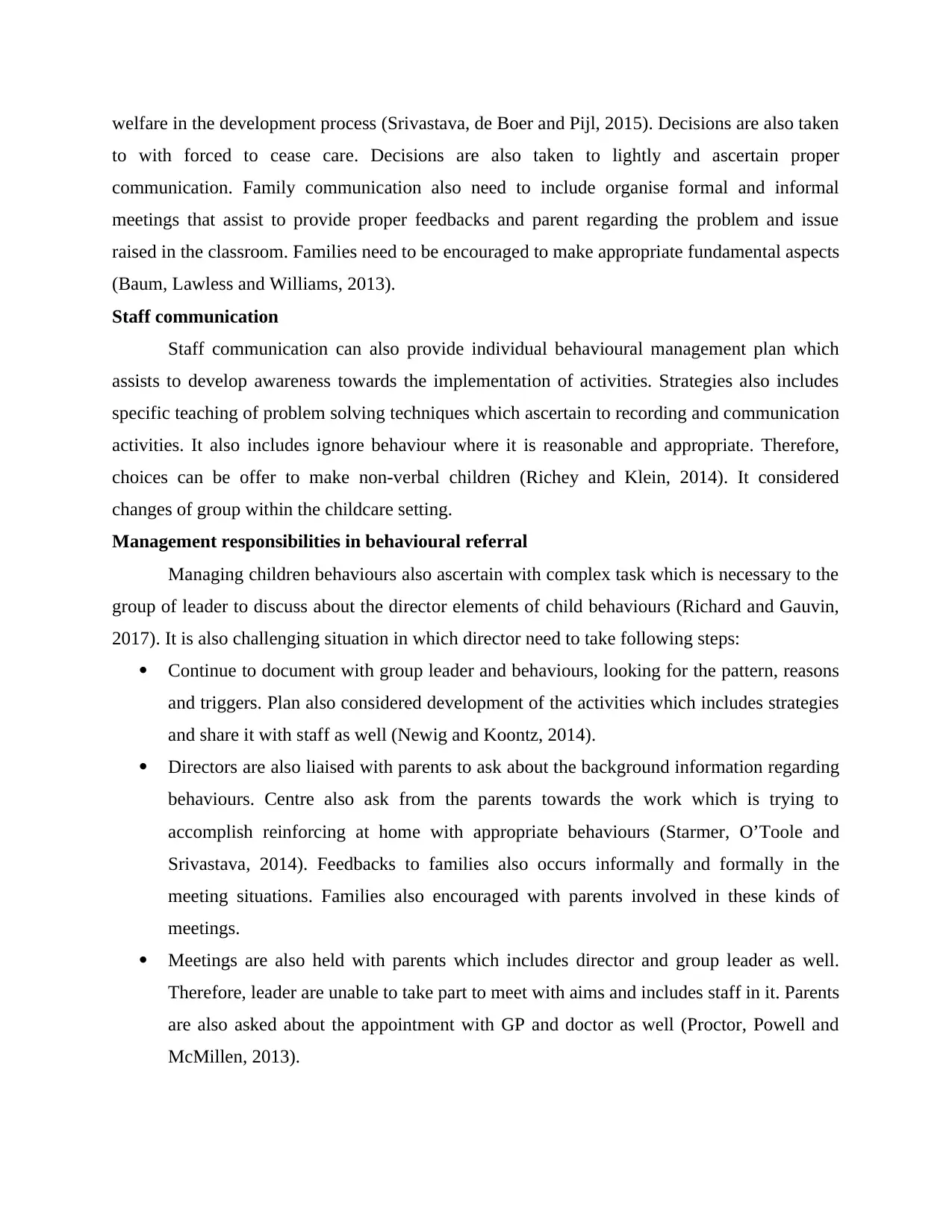
welfare in the development process (Srivastava, de Boer and Pijl, 2015). Decisions are also taken
to with forced to cease care. Decisions are also taken to lightly and ascertain proper
communication. Family communication also need to include organise formal and informal
meetings that assist to provide proper feedbacks and parent regarding the problem and issue
raised in the classroom. Families need to be encouraged to make appropriate fundamental aspects
(Baum, Lawless and Williams, 2013).
Staff communication
Staff communication can also provide individual behavioural management plan which
assists to develop awareness towards the implementation of activities. Strategies also includes
specific teaching of problem solving techniques which ascertain to recording and communication
activities. It also includes ignore behaviour where it is reasonable and appropriate. Therefore,
choices can be offer to make non-verbal children (Richey and Klein, 2014). It considered
changes of group within the childcare setting.
Management responsibilities in behavioural referral
Managing children behaviours also ascertain with complex task which is necessary to the
group of leader to discuss about the director elements of child behaviours (Richard and Gauvin,
2017). It is also challenging situation in which director need to take following steps:
Continue to document with group leader and behaviours, looking for the pattern, reasons
and triggers. Plan also considered development of the activities which includes strategies
and share it with staff as well (Newig and Koontz, 2014).
Directors are also liaised with parents to ask about the background information regarding
behaviours. Centre also ask from the parents towards the work which is trying to
accomplish reinforcing at home with appropriate behaviours (Starmer, O’Toole and
Srivastava, 2014). Feedbacks to families also occurs informally and formally in the
meeting situations. Families also encouraged with parents involved in these kinds of
meetings.
Meetings are also held with parents which includes director and group leader as well.
Therefore, leader are unable to take part to meet with aims and includes staff in it. Parents
are also asked about the appointment with GP and doctor as well (Proctor, Powell and
McMillen, 2013).
to with forced to cease care. Decisions are also taken to lightly and ascertain proper
communication. Family communication also need to include organise formal and informal
meetings that assist to provide proper feedbacks and parent regarding the problem and issue
raised in the classroom. Families need to be encouraged to make appropriate fundamental aspects
(Baum, Lawless and Williams, 2013).
Staff communication
Staff communication can also provide individual behavioural management plan which
assists to develop awareness towards the implementation of activities. Strategies also includes
specific teaching of problem solving techniques which ascertain to recording and communication
activities. It also includes ignore behaviour where it is reasonable and appropriate. Therefore,
choices can be offer to make non-verbal children (Richey and Klein, 2014). It considered
changes of group within the childcare setting.
Management responsibilities in behavioural referral
Managing children behaviours also ascertain with complex task which is necessary to the
group of leader to discuss about the director elements of child behaviours (Richard and Gauvin,
2017). It is also challenging situation in which director need to take following steps:
Continue to document with group leader and behaviours, looking for the pattern, reasons
and triggers. Plan also considered development of the activities which includes strategies
and share it with staff as well (Newig and Koontz, 2014).
Directors are also liaised with parents to ask about the background information regarding
behaviours. Centre also ask from the parents towards the work which is trying to
accomplish reinforcing at home with appropriate behaviours (Starmer, O’Toole and
Srivastava, 2014). Feedbacks to families also occurs informally and formally in the
meeting situations. Families also encouraged with parents involved in these kinds of
meetings.
Meetings are also held with parents which includes director and group leader as well.
Therefore, leader are unable to take part to meet with aims and includes staff in it. Parents
are also asked about the appointment with GP and doctor as well (Proctor, Powell and
McMillen, 2013).
⊘ This is a preview!⊘
Do you want full access?
Subscribe today to unlock all pages.

Trusted by 1+ million students worldwide
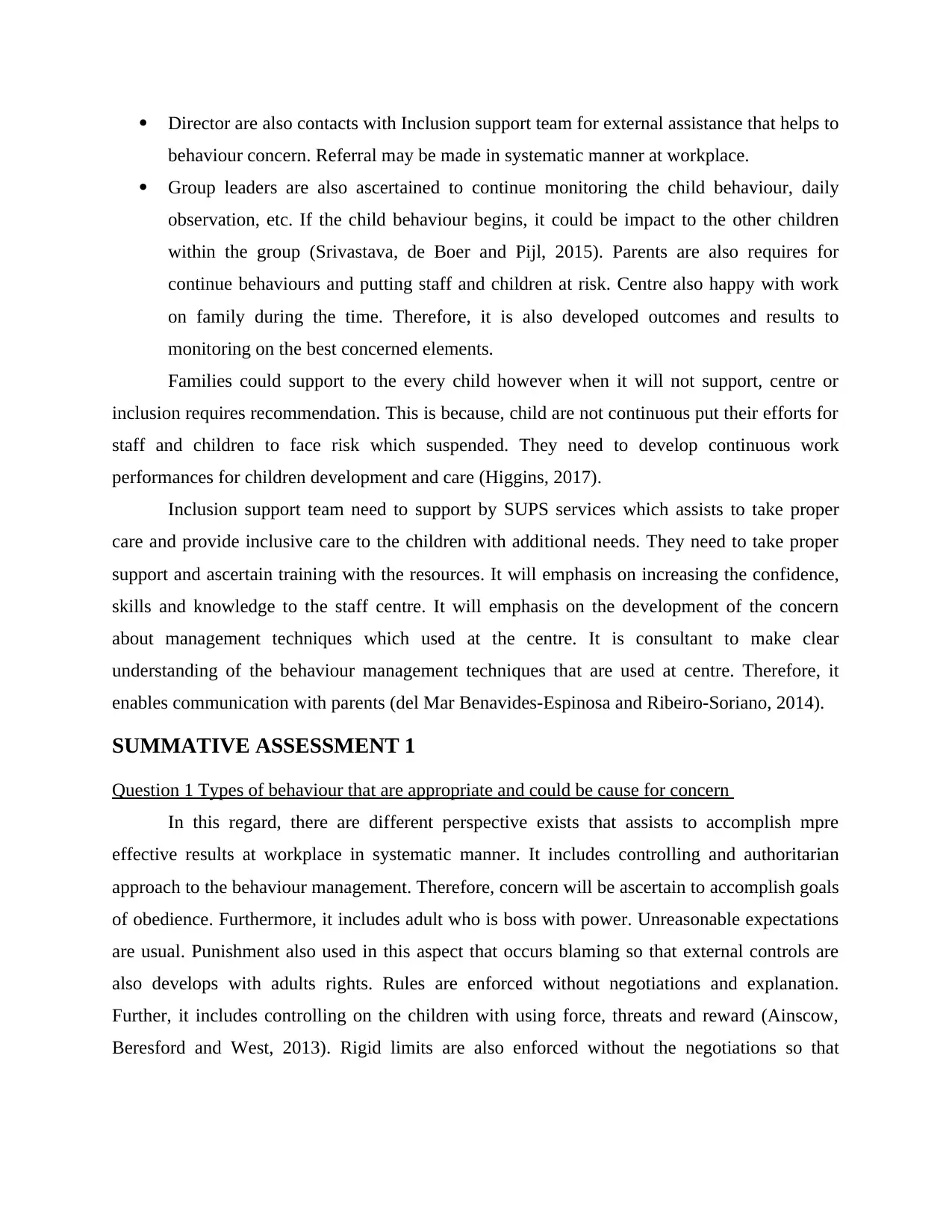
Director are also contacts with Inclusion support team for external assistance that helps to
behaviour concern. Referral may be made in systematic manner at workplace.
Group leaders are also ascertained to continue monitoring the child behaviour, daily
observation, etc. If the child behaviour begins, it could be impact to the other children
within the group (Srivastava, de Boer and Pijl, 2015). Parents are also requires for
continue behaviours and putting staff and children at risk. Centre also happy with work
on family during the time. Therefore, it is also developed outcomes and results to
monitoring on the best concerned elements.
Families could support to the every child however when it will not support, centre or
inclusion requires recommendation. This is because, child are not continuous put their efforts for
staff and children to face risk which suspended. They need to develop continuous work
performances for children development and care (Higgins, 2017).
Inclusion support team need to support by SUPS services which assists to take proper
care and provide inclusive care to the children with additional needs. They need to take proper
support and ascertain training with the resources. It will emphasis on increasing the confidence,
skills and knowledge to the staff centre. It will emphasis on the development of the concern
about management techniques which used at the centre. It is consultant to make clear
understanding of the behaviour management techniques that are used at centre. Therefore, it
enables communication with parents (del Mar Benavides-Espinosa and Ribeiro-Soriano, 2014).
SUMMATIVE ASSESSMENT 1
Question 1 Types of behaviour that are appropriate and could be cause for concern
In this regard, there are different perspective exists that assists to accomplish mpre
effective results at workplace in systematic manner. It includes controlling and authoritarian
approach to the behaviour management. Therefore, concern will be ascertain to accomplish goals
of obedience. Furthermore, it includes adult who is boss with power. Unreasonable expectations
are usual. Punishment also used in this aspect that occurs blaming so that external controls are
also develops with adults rights. Rules are enforced without negotiations and explanation.
Further, it includes controlling on the children with using force, threats and reward (Ainscow,
Beresford and West, 2013). Rigid limits are also enforced without the negotiations so that
behaviour concern. Referral may be made in systematic manner at workplace.
Group leaders are also ascertained to continue monitoring the child behaviour, daily
observation, etc. If the child behaviour begins, it could be impact to the other children
within the group (Srivastava, de Boer and Pijl, 2015). Parents are also requires for
continue behaviours and putting staff and children at risk. Centre also happy with work
on family during the time. Therefore, it is also developed outcomes and results to
monitoring on the best concerned elements.
Families could support to the every child however when it will not support, centre or
inclusion requires recommendation. This is because, child are not continuous put their efforts for
staff and children to face risk which suspended. They need to develop continuous work
performances for children development and care (Higgins, 2017).
Inclusion support team need to support by SUPS services which assists to take proper
care and provide inclusive care to the children with additional needs. They need to take proper
support and ascertain training with the resources. It will emphasis on increasing the confidence,
skills and knowledge to the staff centre. It will emphasis on the development of the concern
about management techniques which used at the centre. It is consultant to make clear
understanding of the behaviour management techniques that are used at centre. Therefore, it
enables communication with parents (del Mar Benavides-Espinosa and Ribeiro-Soriano, 2014).
SUMMATIVE ASSESSMENT 1
Question 1 Types of behaviour that are appropriate and could be cause for concern
In this regard, there are different perspective exists that assists to accomplish mpre
effective results at workplace in systematic manner. It includes controlling and authoritarian
approach to the behaviour management. Therefore, concern will be ascertain to accomplish goals
of obedience. Furthermore, it includes adult who is boss with power. Unreasonable expectations
are usual. Punishment also used in this aspect that occurs blaming so that external controls are
also develops with adults rights. Rules are enforced without negotiations and explanation.
Further, it includes controlling on the children with using force, threats and reward (Ainscow,
Beresford and West, 2013). Rigid limits are also enforced without the negotiations so that
Paraphrase This Document
Need a fresh take? Get an instant paraphrase of this document with our AI Paraphraser
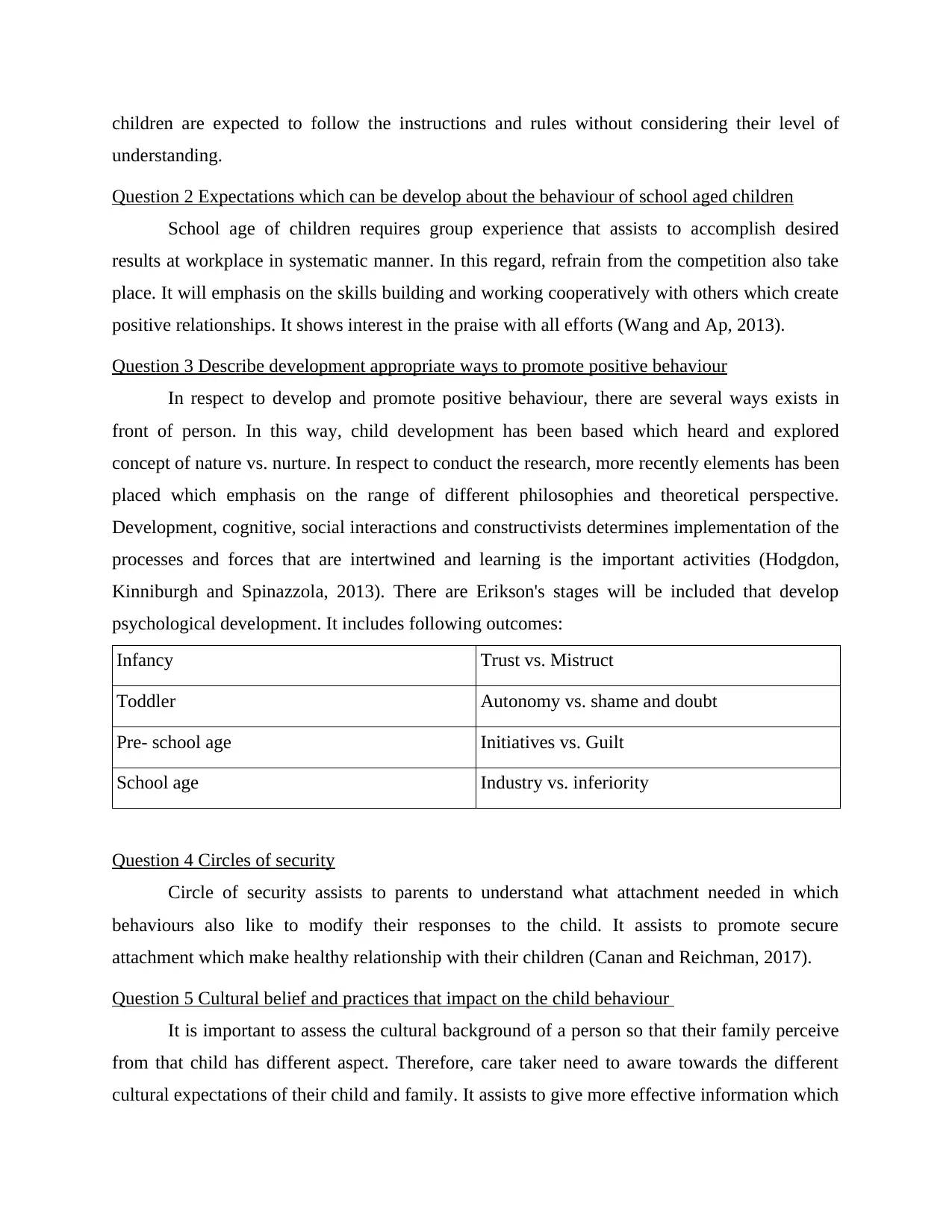
children are expected to follow the instructions and rules without considering their level of
understanding.
Question 2 Expectations which can be develop about the behaviour of school aged children
School age of children requires group experience that assists to accomplish desired
results at workplace in systematic manner. In this regard, refrain from the competition also take
place. It will emphasis on the skills building and working cooperatively with others which create
positive relationships. It shows interest in the praise with all efforts (Wang and Ap, 2013).
Question 3 Describe development appropriate ways to promote positive behaviour
In respect to develop and promote positive behaviour, there are several ways exists in
front of person. In this way, child development has been based which heard and explored
concept of nature vs. nurture. In respect to conduct the research, more recently elements has been
placed which emphasis on the range of different philosophies and theoretical perspective.
Development, cognitive, social interactions and constructivists determines implementation of the
processes and forces that are intertwined and learning is the important activities (Hodgdon,
Kinniburgh and Spinazzola, 2013). There are Erikson's stages will be included that develop
psychological development. It includes following outcomes:
Infancy Trust vs. Mistruct
Toddler Autonomy vs. shame and doubt
Pre- school age Initiatives vs. Guilt
School age Industry vs. inferiority
Question 4 Circles of security
Circle of security assists to parents to understand what attachment needed in which
behaviours also like to modify their responses to the child. It assists to promote secure
attachment which make healthy relationship with their children (Canan and Reichman, 2017).
Question 5 Cultural belief and practices that impact on the child behaviour
It is important to assess the cultural background of a person so that their family perceive
from that child has different aspect. Therefore, care taker need to aware towards the different
cultural expectations of their child and family. It assists to give more effective information which
understanding.
Question 2 Expectations which can be develop about the behaviour of school aged children
School age of children requires group experience that assists to accomplish desired
results at workplace in systematic manner. In this regard, refrain from the competition also take
place. It will emphasis on the skills building and working cooperatively with others which create
positive relationships. It shows interest in the praise with all efforts (Wang and Ap, 2013).
Question 3 Describe development appropriate ways to promote positive behaviour
In respect to develop and promote positive behaviour, there are several ways exists in
front of person. In this way, child development has been based which heard and explored
concept of nature vs. nurture. In respect to conduct the research, more recently elements has been
placed which emphasis on the range of different philosophies and theoretical perspective.
Development, cognitive, social interactions and constructivists determines implementation of the
processes and forces that are intertwined and learning is the important activities (Hodgdon,
Kinniburgh and Spinazzola, 2013). There are Erikson's stages will be included that develop
psychological development. It includes following outcomes:
Infancy Trust vs. Mistruct
Toddler Autonomy vs. shame and doubt
Pre- school age Initiatives vs. Guilt
School age Industry vs. inferiority
Question 4 Circles of security
Circle of security assists to parents to understand what attachment needed in which
behaviours also like to modify their responses to the child. It assists to promote secure
attachment which make healthy relationship with their children (Canan and Reichman, 2017).
Question 5 Cultural belief and practices that impact on the child behaviour
It is important to assess the cultural background of a person so that their family perceive
from that child has different aspect. Therefore, care taker need to aware towards the different
cultural expectations of their child and family. It assists to give more effective information which
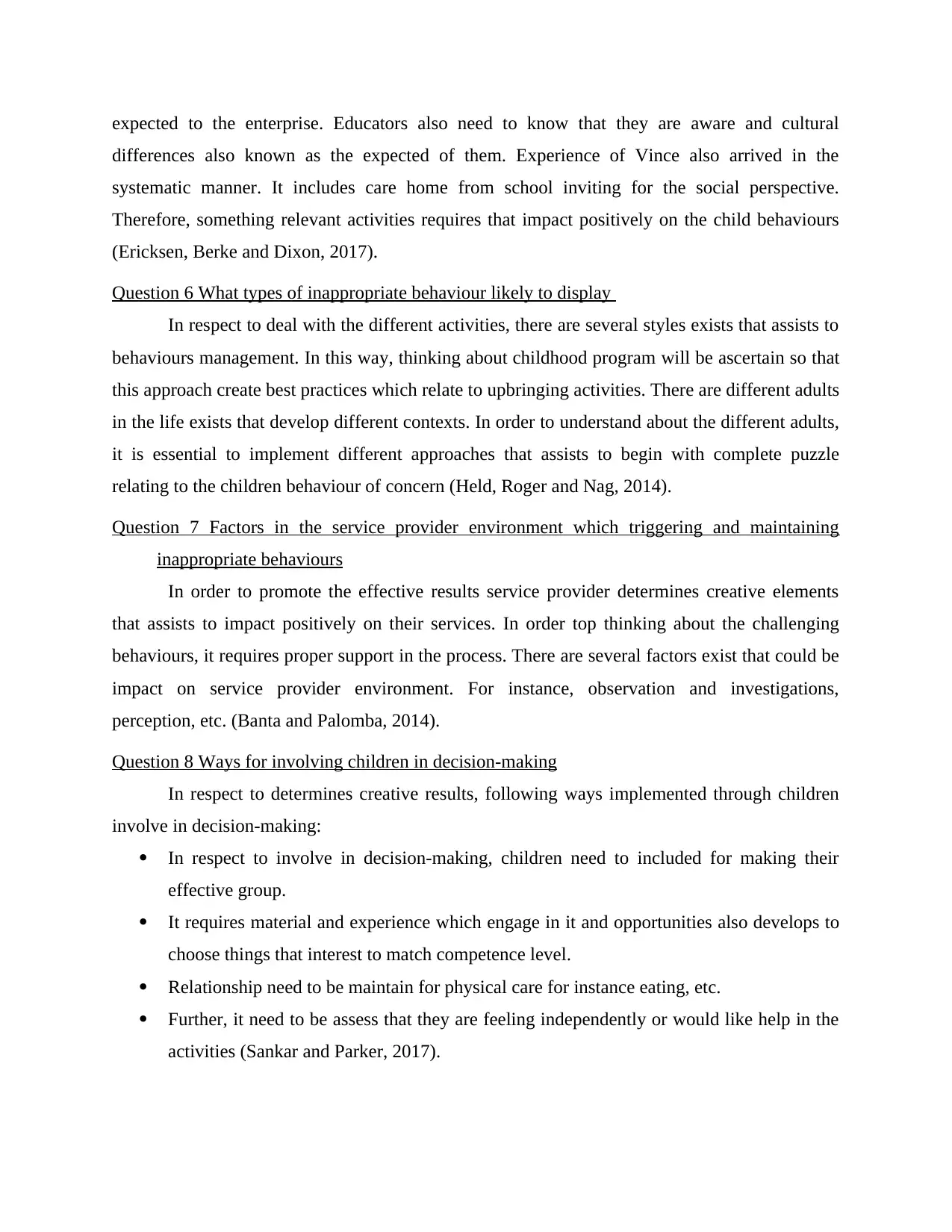
expected to the enterprise. Educators also need to know that they are aware and cultural
differences also known as the expected of them. Experience of Vince also arrived in the
systematic manner. It includes care home from school inviting for the social perspective.
Therefore, something relevant activities requires that impact positively on the child behaviours
(Ericksen, Berke and Dixon, 2017).
Question 6 What types of inappropriate behaviour likely to display
In respect to deal with the different activities, there are several styles exists that assists to
behaviours management. In this way, thinking about childhood program will be ascertain so that
this approach create best practices which relate to upbringing activities. There are different adults
in the life exists that develop different contexts. In order to understand about the different adults,
it is essential to implement different approaches that assists to begin with complete puzzle
relating to the children behaviour of concern (Held, Roger and Nag, 2014).
Question 7 Factors in the service provider environment which triggering and maintaining
inappropriate behaviours
In order to promote the effective results service provider determines creative elements
that assists to impact positively on their services. In order top thinking about the challenging
behaviours, it requires proper support in the process. There are several factors exist that could be
impact on service provider environment. For instance, observation and investigations,
perception, etc. (Banta and Palomba, 2014).
Question 8 Ways for involving children in decision-making
In respect to determines creative results, following ways implemented through children
involve in decision-making:
In respect to involve in decision-making, children need to included for making their
effective group.
It requires material and experience which engage in it and opportunities also develops to
choose things that interest to match competence level.
Relationship need to be maintain for physical care for instance eating, etc.
Further, it need to be assess that they are feeling independently or would like help in the
activities (Sankar and Parker, 2017).
differences also known as the expected of them. Experience of Vince also arrived in the
systematic manner. It includes care home from school inviting for the social perspective.
Therefore, something relevant activities requires that impact positively on the child behaviours
(Ericksen, Berke and Dixon, 2017).
Question 6 What types of inappropriate behaviour likely to display
In respect to deal with the different activities, there are several styles exists that assists to
behaviours management. In this way, thinking about childhood program will be ascertain so that
this approach create best practices which relate to upbringing activities. There are different adults
in the life exists that develop different contexts. In order to understand about the different adults,
it is essential to implement different approaches that assists to begin with complete puzzle
relating to the children behaviour of concern (Held, Roger and Nag, 2014).
Question 7 Factors in the service provider environment which triggering and maintaining
inappropriate behaviours
In order to promote the effective results service provider determines creative elements
that assists to impact positively on their services. In order top thinking about the challenging
behaviours, it requires proper support in the process. There are several factors exist that could be
impact on service provider environment. For instance, observation and investigations,
perception, etc. (Banta and Palomba, 2014).
Question 8 Ways for involving children in decision-making
In respect to determines creative results, following ways implemented through children
involve in decision-making:
In respect to involve in decision-making, children need to included for making their
effective group.
It requires material and experience which engage in it and opportunities also develops to
choose things that interest to match competence level.
Relationship need to be maintain for physical care for instance eating, etc.
Further, it need to be assess that they are feeling independently or would like help in the
activities (Sankar and Parker, 2017).
⊘ This is a preview!⊘
Do you want full access?
Subscribe today to unlock all pages.

Trusted by 1+ million students worldwide
1 out of 30
Related Documents
Your All-in-One AI-Powered Toolkit for Academic Success.
+13062052269
info@desklib.com
Available 24*7 on WhatsApp / Email
![[object Object]](/_next/static/media/star-bottom.7253800d.svg)
Unlock your academic potential
Copyright © 2020–2025 A2Z Services. All Rights Reserved. Developed and managed by ZUCOL.





